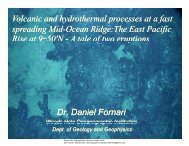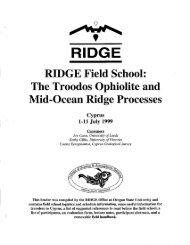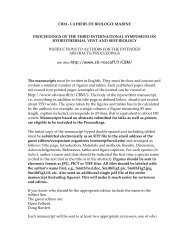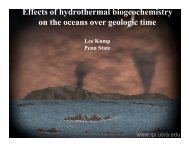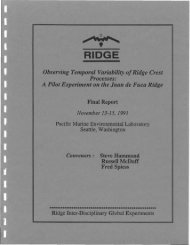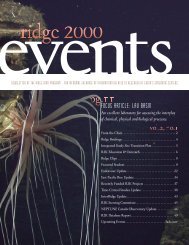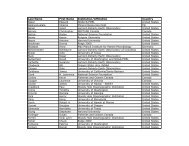You also want an ePaper? Increase the reach of your titles
YUMPU automatically turns print PDFs into web optimized ePapers that Google loves.
most accurate estimates of heat and chemical flux from individual<br />
vent fields. They also are required for optimal placement<br />
of moorings designed to monitor variation in vent-field plumes<br />
with time.<br />
Vent-field monitoring is appropriate over time scales of<br />
weeks to months or longer, in order to measure possible<br />
variations in output resulting from subsurface processes. It<br />
should include thermistors, current meters, transmissometers,<br />
and chemical sensors. Sediment traps and novel remote sensors<br />
such as electromagnetic and acoustic doppler current meters,<br />
acoustic backscattering and tomography devices for measuring<br />
plume structure, and various chemical sensors would also be<br />
useful.<br />
Particles represent a major problem, both in characterizing<br />
their concentration and size distribution and in preventing<br />
their reaction with ambient water after sampling. .!.!:!. situ<br />
pumping and filtration as well as laser particle sizing should<br />
be developed or adapted to solve these problems.<br />
On the scale of one to several ridge segments, or about<br />
200 km along the axis, measurements have traditionally been made<br />
from surface ships. We recommend development of an apparatus<br />
for efficiently detecting and characterizing hydrothermal .<br />
plumes. The apparatus should be compatible with high-speed<br />
("'8 kts) geophysical surveys as well as with slower and more<br />
detailed vent-field surveys. It should at least measure<br />
temperature, conductivity, and light transmittance every 30 m<br />
over the lower 600 m of the water column and also higher, to<br />
detect both normal plumes and larger transient plumes as<br />
discovered in August 1986 on the S. Juan de Fuca <strong>Ridge</strong>. It<br />
could consist of an ROV, or of a towed fiber optic sensor array,<br />
with power supply and data processing equipment located on the<br />
ship rather than on the cable to reduce drag. The apparatus<br />
should be designed to accommodate additional chemical sensors as<br />
they become available.<br />
Monitoring from long-term moorings is also appropriate on<br />
the scale of a ridge segment. primarily to detect large<br />
intermittent, transient plumes such as that noted above, which<br />
had a diameter of 20 km. These moorings could detect a similar<br />
plume if spaced every 10 km. Once detected, it would be<br />
important to track such a plume, possibly with an instrumented,<br />
neutrally buoyant Lagrangrian drifter.<br />
The largest scale with which we are concerned is that of an<br />
ocean basin, equivalent to a 1000 km section of ridge axis. The<br />
apparatus described above, for characterizing plumes, used<br />
either alone or as part of a survey, should be capable of<br />
rapidly determining the presence or absence of plumes along the<br />
ridge axis over these distances. Off-axis advection and<br />
dispersal on the scale of an ocean basin can be evaluated using<br />
56






